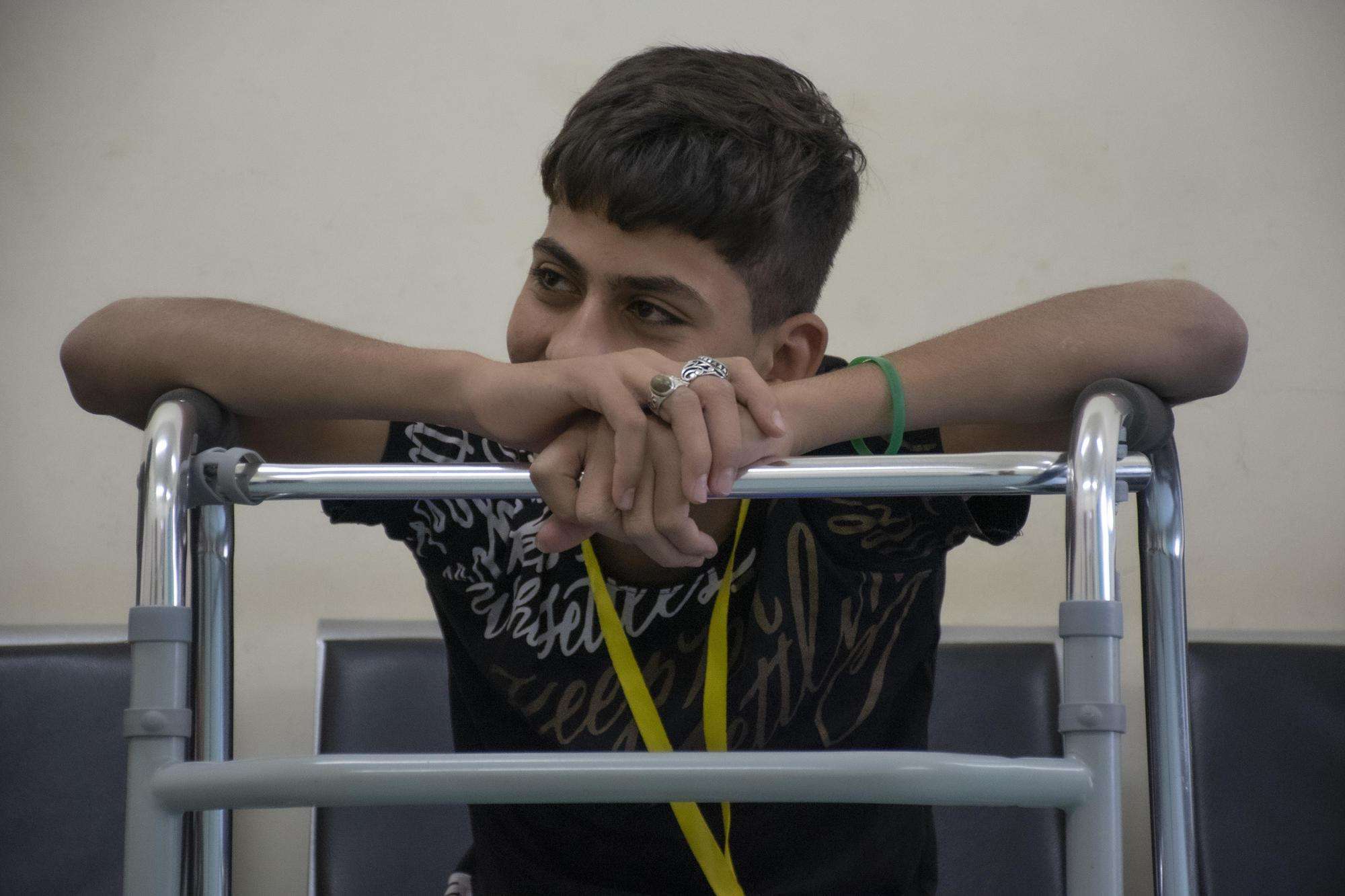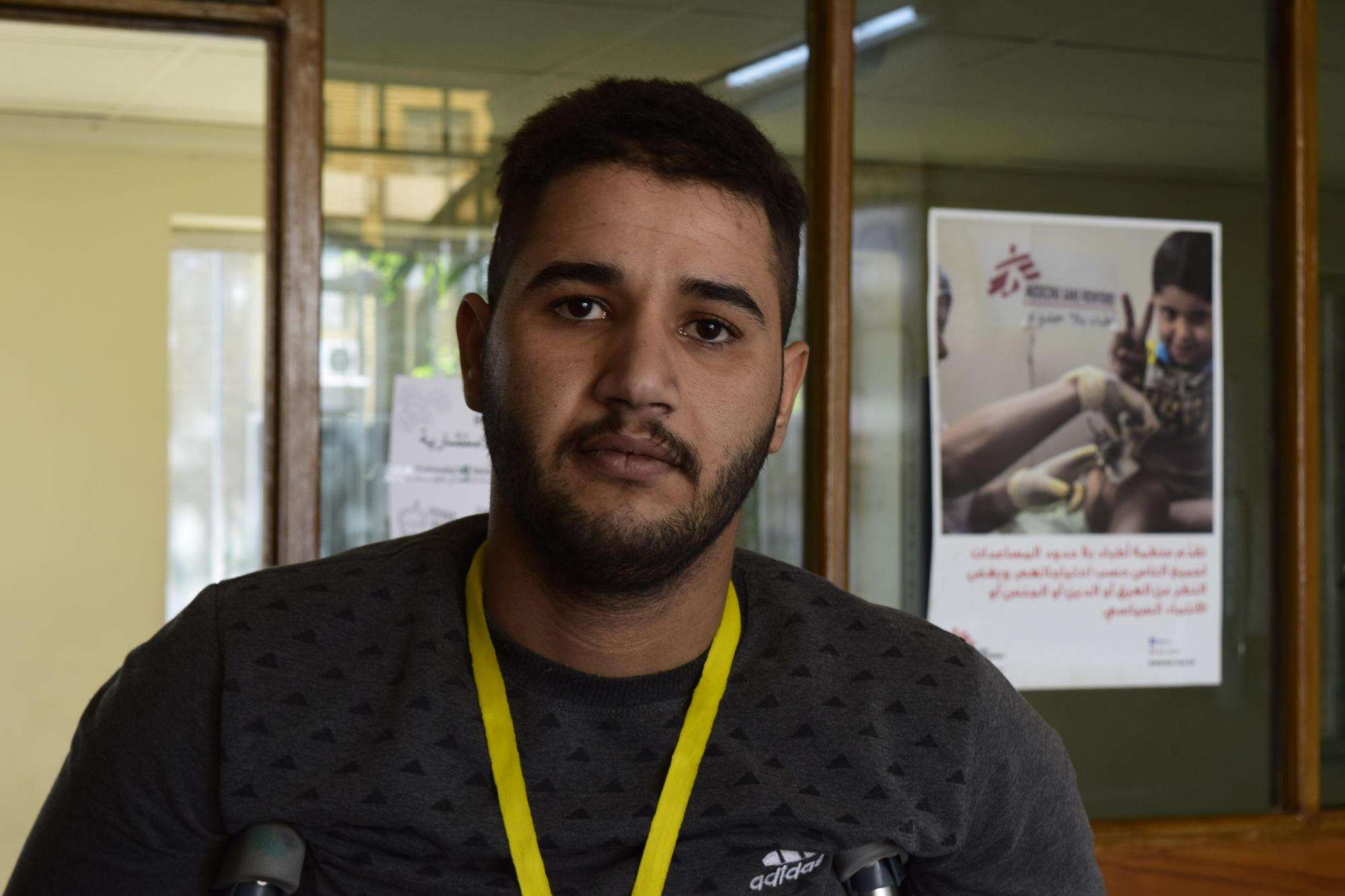In 2017, when the war to retake Iraqi cities from the Islamic State (IS) group was leaving scores of people dead or wounded, Doctors Without Borders/Médecins Sans Frontières (MSF) opened the Baghdad Medical Rehabilitation Center (BMRC) in the Iraqi capital to provide early medical and physical rehabilitation to the men, women, and children injured during the fighting.
As the war faded from the headlines, the BMRC expanded its admission criteria and began to receive survivors of non-violent trauma, such as those involved in traffic and industrial accidents as well as those wounded by ongoing fighting in Baghdad.
When mass protests over deteriorating living conditions, widespread unemployment, and the lack of basic services broke out in Baghdad on October 1, 2019, health facilities in the capital were inundated with people wounded in the violence that accompanied the demonstrations.
From the beginning, MSF kept a close eye on the situation in the capital and reached out to several health facilities to identify their needs, providing donations of emergency medical supplies and support. At the same time, the BMRC, which initially had a 20-bed capacity, was expanded to be able to care for up to 30 patients from October until December. The center treats those in need of early physiotherapy and post-operative care, including mental health support.
"Because of my injury I haven't been working"
At around 9:30 a.m. on October 27, Yasser Falah’s [patient name changed] wife told him that she was pregnant. Two hours later, he was hit by a tear gas canister and rushed in a three-wheeled auto rickshaw, or tuk-tuk, to a nearby hospital. He was then referred to another hospital where he underwent two surgeries before being transferred to the BMRC to start his rehabilitation.

Yasser has trouble falling asleep at night. His mind travels to the country’s north, where he had to dig his mother’s body out of the wreckage of their house following an airstrike during the war to retake Iraqi cities from IS. Despite taking sleeping pills he gets no more than a couple hours of rest at night. He has lost his appetite and only takes a bite from the food stacked next to his bed every now and then.
“I graduated from the Institute of Fine Arts, but after the injury, I lost my craving to draw,” he said. “I always think of my family and my work; I am the only source of livelihood for them but because of my injury I haven’t been working for the past three weeks.”
With the metal spikes of an external fixator sticking out of his left leg, Yasser uses crutches to move around and go see other patients at the BMRC. He loiters on a rooftop to enjoy a few hours of sunlight and some cigarettes along with other patients. They befriend each other up there, where they can share their hopes and worries, vent their emotions, and dream of a speedy recovery and resuming their lives.
Yasser’s concerns are echoed by other patients at the BMRC who were injured during the protests. Many suffer from injuries as severe as the war wounds the hospital team treated during the fighting in 2017.
Lost lives and limbs
It took hours to extinguish and then remove the tear gas canister that was lodged in Saif Salman’s right leg. After several surgeries in different health facilities in Baghdad, the decision was made to amputate it. Any further interventions seemed pointless. It had to be done.

“I was standing on al-Jumhouriyah Bridge when a tear gas canister hit my leg,” he said. “It embedded in my leg and kept on fuming gas. I opened my eyes to tuk-tuk drivers and other people swarming over me. They carried me to a hospital. It’s true, they amputated my leg, but I have two hands and another leg. Three more limbs that I can work with. I didn’t lose anything. In fact, I feel lighter now,” 24-year-old Salman says with a grin.
His sense of humor will help ease the long recovery process, but his trauma and anguish are hidden just below the surface. Salman breaks into tears when he remembers his classmate and friend who was killed during the protests.
“I cannot bear seeing his picture and get sad when I remember him. He didn’t deserve to die—I wish it was me who died, not him,” he said.
Early rehabilitation means better reintegration
Inside the BMRC, a multidisciplinary team of specialized doctors, nurses, physiotherapists, psychologists, and non-medical support staff work not only to treat people in the inpatient department but also to provide outpatient care for those who are well enough to return home.
Their work begins almost as soon as a patient’s anesthetic wears off and the they are referred to the BMRC by a network of doctors in Baghdad’s hospitals or by an MSF team that canvasses hospitals in the city searching for patients in need of intensive post-surgery care and rehabilitation.
“Early medical rehabilitation plays a role in reducing short-term medical ramifications and long-term physical and psychological consequences of injuries,” explained Dr. Aws Khalaf, the BMRC’s Medical activity manager.
Dr. Khalaf said that the consequences of not receiving early post-operative care can include blood clots and infection. By reducing the impacts of the injuries and accelerating the patients’ recovery process, the medical staff at the BMRC “help them to reintegrate in their communities as active individuals, not a burden on other people.”
In addition to the physical rehabilitation, medical staff at the BMRC see mental support as a key component of rehabilitation. In frequent mental health sessions, psychologists and counselors seek to address depression and anxiety amongst patients, deal with their often traumatic memories, and help them adjust to their new realities.
To date, 75 percent of the patients treated by MSF in the BMRC have been discharged with an improved mental health status.

The lasting social impact of violence
Like many of those injured during recent violence in Iraq, 16-year-old tuk-tuk driver Kadhim Dhaygham and his brother were the breadwinners for their family. Like many others, they began to work from an early age due to the same dire economic conditions that pushed them to protest.
On the afternoon of Sunday, October 27, after parking his tuk-tuk near al-Jumhouriyah bridge and trying to cross the street, a tear gas canister slammed into Kadhim’s leg.
“It was so powerful that after hitting the person in front of me, it hit my leg and then the guy behind me. I tried to get up on my feet and started crawling, then one guy carried me to a tuk-tuk,” he said.
The driver brought him to a hospital, and he was referred to another, where he underwent emergency surgery and had an external fixator applied to support his broken bones. Kadhim’s surgeon then referred him to the BMRC, where Kadhim says medical staff “brought life back” to his leg with immediate physiotherapy.
Despite the improvement in his condition, Khadim has begun to feel that he is “deprived of everything.” He feels bitter for not being able to see his friends more often or leave his house. He longs for normal life, enjoying outdoor dinners with friends and tuk-tuk rides in the city. Kadhim, who hails from a poor neighborhood in the eastern part of the Iraqi capital, cannot wait to get back to work and help his older brother provide for his family.
“The two of us are responsible for supporting our family,” he said. “We are like a pair of legs—if one of us falls, the other suffers too.”





